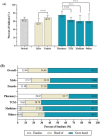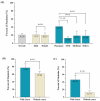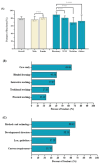Evaluation of the knowledge of and attitudes towards pharmacovigilance among healthcare students in China: a cross-sectional study
- PMID: 38789989
- PMCID: PMC11127336
- DOI: 10.1186/s12909-024-05561-5
Evaluation of the knowledge of and attitudes towards pharmacovigilance among healthcare students in China: a cross-sectional study
Abstract
Background: Knowledge of pharmacovigilance (PV) and adverse drug reactions (ADRs) are the core competencies that healthcare students should acquire during their studies. The objective of this study was to assess attitudes towards and knowledge of PV and ADRs among healthcare students in China.
Methods: An online, cross-sectional survey was conducted nationally among healthcare students in China from April through October 2023. Knowledge of PV and ADRs was assessed using a questionnaire based on current PV guidelines. We performed logistic regression analysis to determine the potential factors related to knowledge of and attitudes towards PV and ADRs.
Results: A total of 345 students were included in the analysis. Among the healthcare students who participated in the survey, 225 (65.22%) students correctly defined PV, while only 68 (19.71%) had a correct understanding of ADRs. Among all respondents included in the analysis, only 71 (20.58%) reported having taken a PV course. Pharmacy students were more likely to have taken PV courses at a university and to demonstrate superior knowledge compared to other healthcare students. The logistic regression model revealed that the significant predictors of a higher level of PV knowledge were being female (odds ratio [OR]: 1.76; 95% confidence interval (CI): 1.06-2.92; P value: 0.028) and having previously taken PV-related courses (OR: 2.00; 95% CI: 1.06-3.80; P value: 0.034).
Conclusions: This study revealed that healthcare students' knowledge of PV and ADRs is unsatisfactory. However, there were a limited number of universities providing PV education. Given the vital role of healthcare professionals in identifying and reporting ADRs, our findings raise significant concerns. Hence, more efforts should be made to enhance PV education for future healthcare professionals.
Keywords: Education; Knowledge; Pharmacovigilance; Survey.
© 2024. The Author(s).
Conflict of interest statement
The authors declare no competing interests.
Figures




Similar articles
-
Pharmacovigilance in healthcare education: students' knowledge, attitude and perception: a cross-sectional study in Saudi Arabia.BMC Med Educ. 2020 Jul 2;20(1):210. doi: 10.1186/s12909-020-02116-2. BMC Med Educ. 2020. PMID: 32616054 Free PMC article.
-
An evaluation of the knowledge and perceptions of pharmacy students on pharmacovigilance activities in Nigeria.BMC Res Notes. 2017 Jul 12;10(1):273. doi: 10.1186/s13104-017-2586-9. BMC Res Notes. 2017. PMID: 28697738 Free PMC article.
-
Knowledge, attitudes and practice regarding pharmacovigilance and adverse drug reaction reporting among physicians and pharmacists in Egypt: a step toward personalized medicine implementation.Per Med. 2022 Nov;19(6):495-507. doi: 10.2217/pme-2022-0030. Epub 2022 Oct 14. Per Med. 2022. PMID: 36239598
-
Knowledge, attitude, practice and barriers towards pharmacovigilance and adverse drug reactions reporting among healthcare professionals in Turkey: a systematic review.Curr Med Res Opin. 2022 Jan;38(1):145-154. doi: 10.1080/03007995.2021.1997287. Epub 2021 Nov 3. Curr Med Res Opin. 2022. PMID: 34694167
-
Urgent need to modernize pharmacovigilance education in healthcare curricula: review of the literature.Eur J Clin Pharmacol. 2018 Oct;74(10):1235-1248. doi: 10.1007/s00228-018-2500-y. Epub 2018 Jun 20. Eur J Clin Pharmacol. 2018. PMID: 29926135 Free PMC article. Review.
Cited by
-
Assessment of knowledge and perceptions of pharmacy students toward pharmacovigilance activities, and their predictors: a cross-sectional study in Palestine.BMC Med Educ. 2025 Jul 17;25(1):1067. doi: 10.1186/s12909-025-07575-z. BMC Med Educ. 2025. PMID: 40676624 Free PMC article.
References
-
- World Health Organization. Pharmacovigilance: ensuring the safe use of medicines. www.who.int/medicines/areas/quality_safety/safety_efficacy/pharmvigi/en/. Accessed 22 October 2023.
MeSH terms
LinkOut - more resources
Full Text Sources
Miscellaneous

